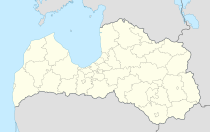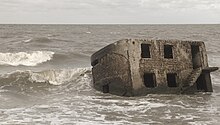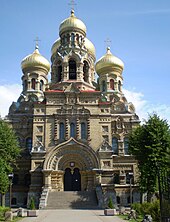Karosta
| Karosta | ||
|---|---|---|
 Help on coat of arms |
|
|
| Basic data | ||
| State : |
|
|
| Landscape: | Courland ( Latvian : Kurzeme ) | |
| Administrative district : | Republic-city of Liepāja | |
| Coordinates : | 56 ° 33 ' N , 21 ° 0' E | |
| Residents : | 7,500 (Jul 1, 2009) | |
| Area : | ||
| Population density : | ||
| Height : | ||
| Website: | www.liepaja.lv | |
| Post Code: | ||
| ISO code: | ||
| former fort | ||
Karosta is a district in the north of the Courland city of Liepāja in Latvia . It covers about a third of the city area and was a naval port of the Russian Empire and the Soviet Union.
history
Originally, Karosta was a base of the Russian Baltic Sea Fleet , which was chosen not least because of its proximity to the German border near Nimmersatt and its year-round freedom from ice. It was created from 1890 at the behest of Tsar Alexander III . and his son Nikolai II . He called it "Port of Alexander III." The name Alexander is still widespread in Karosta among the approximately 70 percent Russian-speaking population.
At the beginning of the 20th century, Kara-Osta ( Latvian for naval port ) formed its own Russian military district . For a long time there was no exchange between Karosta and Liepāja. Its own post office , the largest Orthodox church in Latvia , its own energy supply and extensive infrastructure illustrate the special role of Karosta. For example, a postcard from Kara-Osta to Liepaja cost as much with three kopecks as to Vladivostok just before the Korean border . The supply situation for the members of the Soviet armed forces was often better than for the Latvian population of Liepaja. For reasons of military security, Liepaja was partially not included in Soviet maps.
With the dissolution of the Soviet Union, Estonia, Latvia and Lithuania became independent again and the Soviets had to withdraw. After the relocation of around 20,000 to 26,000 Soviet soldiers from the former main base of the Russian Baltic Sea Fleet with around 30 nuclear submarines and 140 warships , Karosta became a neglected and only about one third inhabited district of Liepājas. Chemical weapons and radioactive waste from the naval base are said to have been sunk in the Baltic Sea off Gotland between 1989 and 1992 before the Soviet withdrawal .
Forts and Kara-Osta Canal
The forts built between 1893 and 1906 (in the north) were abandoned in 1914 and have been worn away by the waves ever since. These forts and the canal were the first structures in Karosta. Similar forts were built throughout the Russian Empire , including in Port Arthur (today a district of Dalian and China's second largest port ).
Kara-Osta Canal and the "rotating iron bridge"
A branch of the canal is intended for ships and submarines. There are also docks and shipyards. The Kalpaka Bridge, built in 1906, is the only swing bridge in Latvia and is still in operation with brief interruptions. After a ship collision in mid-2006, it was temporarily unusable and was renewed in 2009.
North pier
The north pier was built with the canal and is about two kilometers long. It took about two years to build. From there you have a good view of the harbor. The place is popular with Liepāja's residents and guests.
St. Nicholas Cathedral
The Orthodox Cathedral of St. Nicholas is one of the landmarks of Karosta. Architects were Sergei Gelensowski and Vasily Kossjakow from Petersburg.
jail
The prison Karosta in invalidů Road 4 was built in the early 20th century. Initially planned as a war hospital , it was never used that way. As early as 1905, the garrison seamen who had taken part in the revolutionary events were in prison . The building later served as the main guard prison for both the Soviet Army and naval troops of the Latvian Army . The last traces left by convicts on the cell walls date back to 1997. Today, the main guard can be visited for a small fee and performances “Behind the bars” are offered. Visitors can spend the night in a cell and dine in a Soviet-style canteen.
Web links
Individual evidence
- ↑ Frankfurter Rundschau, February 5, 2010




